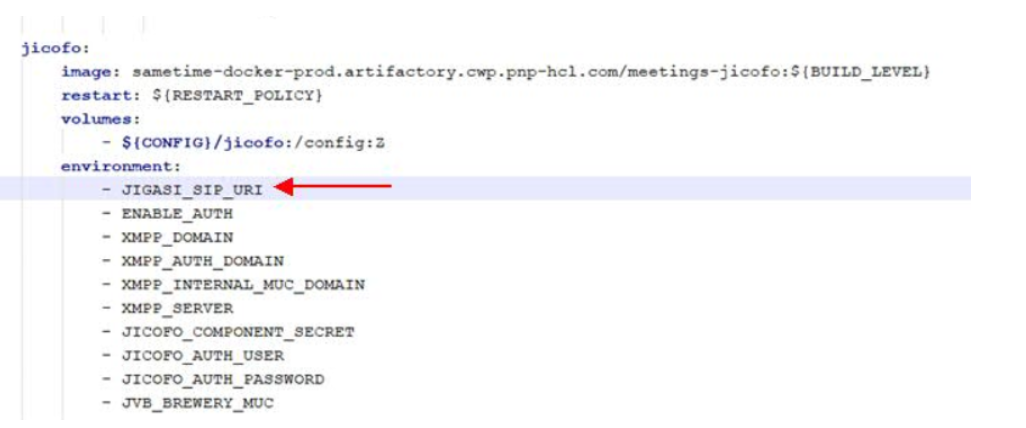Enabling Meeting Dial-out
You can enable the Dial-out option on Docker and Kubernetes.
Docker
Procedure
-
Edit the .env file and save the changes.
Do not include the comments which are in parentheses ().
JIGASI_SIP_SERVER= (This is the SIP server/proxy IP or hostname. For hostname, this must be in DNS or added as extra_hosts entry in docker-compose.yml for the jigasi service.) JIGASI_SIP_PORT=5060 (This is the SIP server/proxy port) JIGASI_SIP_TRANSPORT=UDP (This is SIP server/proxy protocol) JIGASI_SIP_URI= (This is the SIP URI, in plain text. Example: [mailto:mysipuser@mysipserver.com mysipuser@mysipserver.com] ) JIGASI_SIP_PASSWORD= (This is the SIP user password, in plain text.) -
Edit the
docker_compose.ymland save the changes.Note: The “-“ is required in front of the parameter.Under the JIGASI environment section, add the statement:– JIGASI_PROXY_BYPASS. Under NGINX environment section, add the statement:
Under NGINX environment section, add the statement:- ENABLE_INVITE_OTHERS=true. Under JICOFO environment section, add the statement:
Under JICOFO environment section, add the statement:- JIGASI_SIP_URI.
-
Apply the settings to Docker.
To apply these settings to Docker, perform the following:
cd to directory holding docker-compose.yml > docker-compose down > rm -rf jitsi-config/jigasi > docker-compose up -d
Kubernetes
Procedure
-
Edit the helm/values.yaml file and change the enableJigasi to
“true” (default is false).
Add the following settings. Do not include the comments which are in parentheses ().
jigasiSipServer: (This is the SIP server/proxy IP or hostname. For hostname, this must be in DNS or added to CoreDNS config of Kubernetes.) jigasiSipPort: 5060 (This is the SIP server/proxy port) jigasiSipTransport: UDP (This is the SIP server/proxy protocol) jigasiProxyBypass: true (If the SIP proxy is the only network path to the SIP infrastructure, this must be “false”. If the meeting infrastructure can directly hit the SIP endpoints, such as the SIP gateway to the PSTN, “true” can be set to bypass the proxy after a call is set up.) ENABLE_INVITE_OTHERS: true -
Configure the SIP user account credentials by adding the following to the
helm/templates/meeting-secrets.yaml file.
Do not include the comments which are in parentheses ().
JigasiSipUri: (This is the base64 encoded sip URI value. Copy/Paste the output from the command: "echo -n 'mysipuser@mysipserver.com' | base64" ) JigasiSipPassword: (This is the base64 encoded password of the SIP user/ Copy/Paste the output from the command: "echo -n 'myuserpassword' | base64" ) - Apply the updated settings to Kubernetes.
-
Run the command
helm listto find out the deployment name and current version. This is needed in the event a roll-back is needed. -
Perform an upgrade using the helm upgrade meetings helm/ command where
helm/ is the directory with the updated deployment/config.
If there is a failure, rollback changes with the command: helm rollback meetings 11 which reverts the failed upgrade back to the working revision.